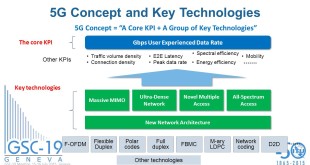Transmission Line principles Transmission lines are means of transporting RF energy between subsystems. A simple wire lead does not work well for RF and microwave applications due to its large dimensions relative to a wavelength and losses due to the skin effect. To take into account the unique characteristics of …
Read More »TimeLine Layout
May, 2023
-
4 May
US Army’s “Project Convergence” evaluating technologies, Joint and Multinational interoperability for A2/AD and Multidomain capability
Russia and China have developed sophisticated military capability for A2/AD and Multidomain capability. Anti-Access is defined as any action, activity, or capability, usually long-range, designed to prevent an advancing military force from entering an operational area. Area Denial is defined as action, activity, or capability, usually short-range, designed to limit an …
Read More » -
3 May
Rising Open Source Intelligence (OSINT) importance for Military
Intelligence, in military science, information concerning an enemy or an area. The term is also used for an agency that gathers such information. Military intelligence is as old as warfare itself. Even in biblical times, Moses sent spies to live with the Canaanites in order to learn about their ways and …
Read More » -
2 May
MEMS Manufacturing
Mechanical-Systems (MEMS) is the integration of mechanical elements (levers, springs, deformable membranes, vibrating structures, etc.), sensors, actuators, and electronics (resistors, capacitors, inductors, etc.) on a common silicon substrate through microfabrication technology. MEMS devices are today considered as one among the most promising technologies of this century, capable to revolutionize the …
Read More » -
1 May
Embedded System Market
An “embedded system” is a word made by shortening “computer embedded system” meaning a system product or an electronic device into which a computer has been integrated. An embedded system is a controller that sits within a larger system in order to perform a dedicated function. An embedded system is …
Read More »
April, 2023
-
30 April
Electric Vehicle Charging technologies and innovations
A typical passenger vehicle emits about 4.6 metric tons of carbon dioxide per year. This assumes the average gasoline vehicle on the road today has a fuel economy of about 22.0 miles per gallon and drives around 11,500 miles per year. Every gallon of gasoline burned creates about 8,887 grams …
Read More » -
29 April
Quantum entanglement for futuristic energy storage technology
One of the most important features of thermodynamics is that it has improved human quality of life amazingly during the last centuries. Since in 1606, the Spanish inventor Jerónimo de Ayanz y Beaumont patented the first steam engine a great effort has been done in developing new and better thermal …
Read More » -
28 April
DARPA EC developing AI based military sensor fusion technologies to optimally combine information originating from multiple heterogeneous sensors and subsystems.
Current artificial intelligence (AI) systems only compute with what they have been programmed or trained for in advance; they have no ability to learn from data input during execution time, and cannot adapt on-line to changes they encounter in real environments. The AIE program is one key element of …
Read More » -
28 April
5G key technologies from Radio interface, multiple access schemes, 5G Networking to Cognitive networks driving Worldwide Race
Mobile communications systems have evolved through wireless technology innovation into 2G, 3G, and then 4G to keep pace with ever-increasing voice and data traffic. All mobile communication system generations have had a clear key application driver: 1G for analog voice, 2G for digital voice and text messaging, 3G for multimedia …
Read More » -
27 April
DARPA HARDEN developing designs and tools for trusted computing systems
Hardware Trojans (HT), which are malicious circuit inclusions into the design from an adversary with an intention to damage the functionality of the chip at a much later date or leaking confidential information like keys used in cryptography. Time to market demand has forced integrated circuit design, manufacturing and testing …
Read More »
 International Defense Security & Technology Your trusted Source for News, Research and Analysis
International Defense Security & Technology Your trusted Source for News, Research and Analysis
